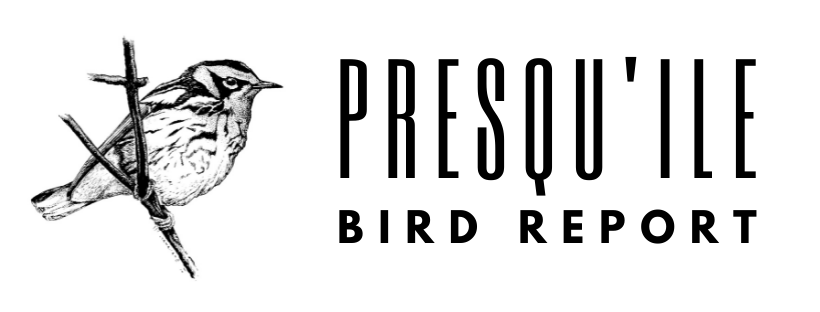Birding Report
Presqu’ile Bird Report for 11-17 Oct 2019
There has not been a significant change in birdlife since last week’s report. Migration carries on but without any large movements and, for the most part, what we are seeing are the “usual suspects” for this time of year.
Most puddle ducks are around in the marsh or around the islands but there are no big concentrations yet. Similarly diving ducks while present, have not appeared in any numbers yet. Three SURF SCOTERS were seen on 13 Oct plus a single the next day. Four WHITE-WINGED SCOTERS were also seen on 13 Oct. Once we get a serious cold front passing through we should see more northern ducks arriving. RUFFED GROUSE were heard drumming on 13 and 15 Oct. WILD TURKEYS are now being seen along the roadside more frequently as well. The only heron apart from GREAT BLUE HERON was a GREAT EGRET seen in the causeway marsh on 13 Oct.
Although most expected raptors have been reported we still have not seen a significant migration movement on the shoreline this fall, which is a bit unusual. BALD EAGLES are becoming more obvious with an adult on 16 Oct, and three immature on 17 Oct. AMERICAN COOTS were seen in the marsh again this week with two on 13 Oct and one on 15 Oct. There was very little coverage of shorebirds and Gull Is. this week but a few things were around. BLACK-BELLIED PLOVERS peaked with 9 on 11 Oct and 7 SEMIPALMATED PLOVERS on 11 Oct was the high count for that species. Other shorebirds included two SANDERLING and two PECTORAL SANDPIPER on 11 Oct, and a LEAST and two PECTORAL SANDPIPERS on 13 Oct. An AMERICAN WOODCOCK was seen flying across the main road at dusk on 14 Oct.
No unusual gulls were seen this week but big feeding flocks are starting to form offshore and should be checked for rarities mixed in with the abundant HERRING GULLS. A PEREGRINE FALCON was on Gull Is. on 13 Oct. Several BLUE-HEADED VIREOS were reported this week with the last on 15 Oct. A HORNED LARK was on the beach on 11 Oct and seen by three different parties. GRAY CATBIRD was reported on 11 Oct and 13 Oct. AMERICAN PIPITS have been oddly scarce this fall – two on 13 Oct being the only report this week. CEDAR WAXWINGS have likewise been scarce with two on 15 Oct being the only report despite an excellent crop of Red Cedar berries in the Calf Pasture.
Several warblers continue to linger. Apart from YELLOW-RUMPED WARBLER which were around in small numbers through the period, late birds included: an ORANGE-CROWNED WARBLER on 11 Oct; AMERICAN REDSTART on 11 Oct; NORTHERN PARULA on 11 OCT; three BLACK-THROATED BLUE WARBLER on 11 Oct and one on 15 Oct; and BLACK-THROATED GREEN WARBLER on 11 and 15 Oct.
Sparrows continue to move through although no unusual species were detected. Three EASTERN TOWHEES were still around on 15 Oct. A SAVANNAH SPARROW was seen on 11 Oct. Big flocks of RED-WINGED BLACKBIRD and COMMON GRACKLE can be seen going to roost in the marsh each evening. Three RUSTY BLACKBIRDS were seen on 13 Oct and a single was singing by the gate on 15 Oct.
Presqu’ile allows waterfowl hunting on Mondays, Wednesday, Friday and Saturday and the public is not permitted in hunting areas on those days. The areas affected are the marsh, Calf Pasture Point, Gull and High Bluff Is., and later in the season, Owen Pt. At the present time you may go to the tip of Owen Pt. on a hunting day, but not beyond the sign. Once a blind is placed on Owen Pt. in November, access to Owen Pt. will be closed. The hunt will continue until 21 December.
Directions: Presqu’ile Provincial Park is located on the north shore of Lake Ontario, just south of the town of Brighton. It can be reached from either Hwy. 401, or Cty. Rd. 2 and is well signed. A Park map can be found in the information tabloid available at the Park gate. Presqu’ile’s two offshore islands – Gull and High Bluff – support a large multi-species colonial bird nesting area and access is not permitted during the breeding season (10 March-10 September).



